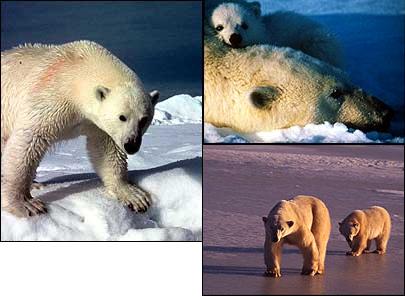New studies indicate that thousands of polar bears are in danger, due to chemical gases emitted into the Arctic region from industrialized countries

New evidence suggests that polar bears are suffering from chemical gases emitted into the Arctic from industrialized countries by winds and currents. The data were presented at a conference of the WWF, the global conservation organization, which took the opportunity to call for an immediate reduction of gas emissions, including the new ones that are considered more environmentally friendly, but in fact also cause damage.
Three recently published scientific studies indicated that polar bears are already regularly harmed by various pesticides and gases, and the WWF used them for their support. Nearly 22 thousand polar bears live in the Arctic region and are threatened by additional elements of global warming and changing the conditions of the natural living environment.
Although certain gases such as pesticides and polychlorinated biphenyls have been banned for use since 2001, their effect is still evident, and new studies have even indicated residues of new chemicals. Dr. Andrew Drocher, a scientist from the University of Alberta, who contributed to all the recent studies, said: "Most of these bears have a lot of chemicals in their bodies, man-made, and they have no way of dealing with it."
Contaminated bear
New evidence of the impact of pollutants on polar bears
The World Wildlife Fund presented new evidence that polar bears suffer from industrial chemicals coming from countries located thousands of kilometers south of the North Pole. The foundation calls for a broader ban on the dumping of toxic chemicals. These include some substances of the newer generation, which are supposed to be less harmful than the "polluted dozen" that were outlawed at the UN conference in 2001.
"Three recently published scientific studies provide solid evidence that polar bears are harmed by toxic chemicals and pesticides, which are already affecting them," the organization said in its report. The foundation calls for the elimination of the use of most dangerous chemicals. According to her, the studies only add to the evidence regarding the pollution of the North Pole as a result of chemical substances washed north from countries in the south by the winds and currents.
According to the estimate, about 22 thousand bears live in the North Pole, who have to face additional threats such as global warming and the loss of their natural environment.
Toxic chemicals can stay in the environment for years and accumulate in the fatty tissues of the animals. Some studies have traced the traces of new chemical substances, including types of fire-resistant materials.
The three studies testified to a connection between high levels of toxic chemicals and pesticides in the polar bears in Canada and the Norwegian island of Svalbard and the lack of antibodies in their blood, which make the bears more vulnerable to infections.
These studies also revealed changes in hormone levels, the consequences of which may be many - reproductive problems, behavior and more. "Most polar bears have several hundred man-made chemicals in their bodies and they have never developed mechanisms to deal with them," said Andrew Druscher, a scientist at the University of Alberta who participated in all the recent studies. "It is unlikely that the unintended change in the hormone levels and immune system of the polar bears will be good for them."
"The day-to-day use of pollutants continues in manufacturing processes around the world," said Brittany Walker, who is responsible for the field of toxins in the World Wildlife Fund's Arctic Program. "It is essential to prevent the accumulation of the new chemicals and the pollution of the environment." The World Wildlife Fund is calling for stricter laws to be enacted in line with EU proposals.
For news at the BBC

One response
Read everything and I'm nervous so hurry....!!!!!